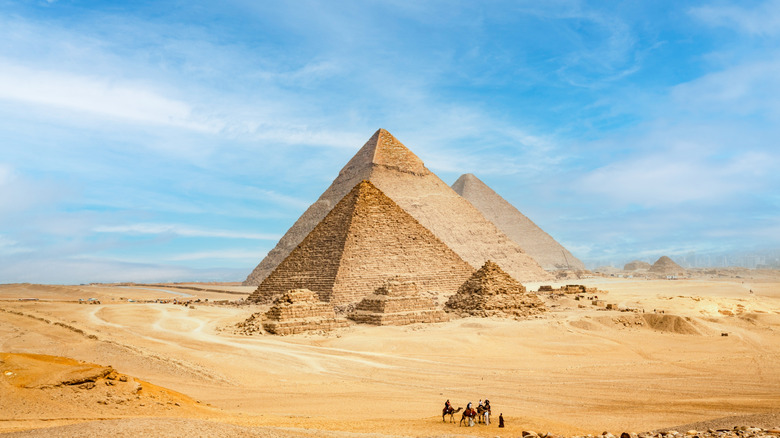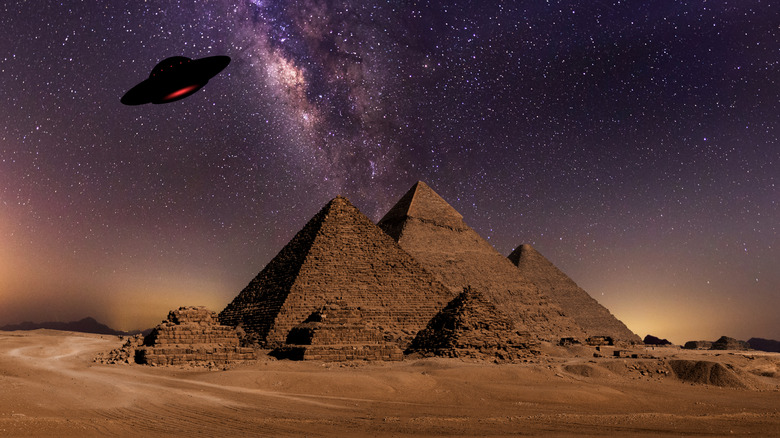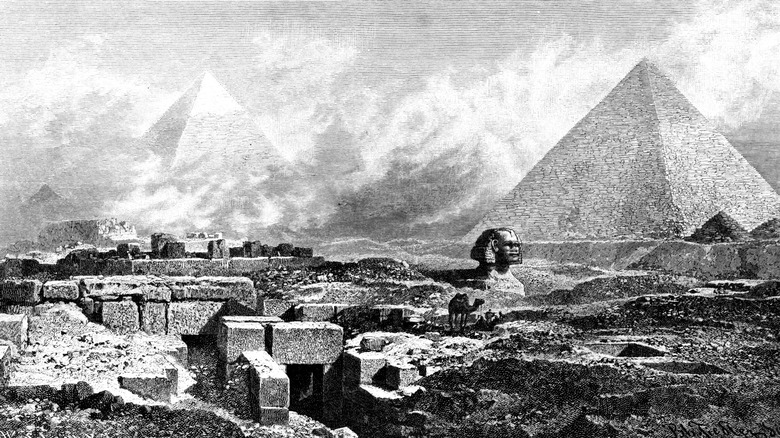The Wildest Theories On How The Ancient Egyptians Actually Built The Pyramids
Egypt is a country brimming with remarkable monuments that draw millions of tourists from around the world annually and provide incredible insight into the craftsmanship and ingenuity of its ancient people. There's the mysterious Sphinx, a lion with the face of a woman standing 66 feet tall 4,500 years after its construction, as well as the Valley of the Kings, the resting place of more than 60 royal figures who ruled three millennia ago.
But without doubt the crown jewels of Egypt's historic attractions are the Pyramids of Giza, which stand just to the southwest of Cairo and are visited by some 2.5 million people every year. Huge monuments that reach high into the desert air, they remain as striking today as they must have been for the ancient Egyptians who gazed upon them years ago. At the time, they saw them as evidence of the divinity of Egyptian pharaohs and the gods from whom they claimed their sovereignty.
The social structure of ancient Egypt was brutally hierarchical, with historians in general agreeing that countless enslaved people were exploited in the building of the pyramids and other nearby ancient landmarks. But not everyone is convinced. Indeed, according to several wild, fringe theories, there was something else other than slavery behind the construction of this wonder of the ancient world.
They were built by aliens
Possibly the most famous of the fringe theories concerning the construction of the Great Pyramids of Giza is the idea that they were the work of extraterrestrials. The hypothesis is widespread, especially on the internet, where it is the subject of countless forums and YouTube videos. The idea that the ancient Egyptians must have had extraterrestrial aid when it came to building the Great Pyramids of Giza hinges on the notion that the civilization alone did not have the technology to create such impressive structures.
Proponents of the theory point to the fact that pyramids are found across the globe — most famously perhaps in Mexico and Peru. This, they say, is evidence that the same technology was seeded across various civilizations by aliens moving across the planet in a manner that ancient people were unable to do. Some even say that the murals of ancient Egyptians discovered by historians depict the arrival of alien craft — true historical events that the Egyptians recorded for posterity.
On the other hand, critics of the theory note that pyramids are a fundamental constructive shape. If an infant decides to pile sand, it creates something akin to a pyramid, and little engineering knowledge is required to pile the stones that created the Great Pyramids of Giza despite the chambers they contain. It makes sense that disparate civilizations — whose pyramids nevertheless vary radically in style — could have settled on the shape separately. Similarly, few respected Egyptologists have recognized anything like a spacecraft in the art of the period, with simple explanations noting the existence of "palimpsests," layers of hieroglyphs that have combined to make unintended shapes when plaster has fallen away. These can subsequently be misinterpreted, such as when sun imagery is perceived as a UFO.
They were created by Noah
It's not just believers in alien visitors who have made bold claims about who built the Great Pyramids. For some religious observers, there is a Judeo-Christian claim that the Biblical patriarch, Noah, was responsible for their construction. According to the Book of Genesis, faithful and righteous Noah and his family were selected by God to be saved from a great flood that engulfed the Earth. The event wiped out the rest of humanity after God judged them for their wickedness. Noah was instructed to construct a great Ark, or boat, on which he was to gather with two of each animal, allowing humanity and the fauna of the Earth to repopulate after the flood abated. The story is contentious even among religious observers — many consider it a fable, while more literal believers claim it is a true story. As of yet, no geological evidence exists that such a mighty flood ever occurred.
But how is the story of Noah's Ark linked to the Great Pyramids of Giza? Well, according to some theorists, such as "Ancient Architects" YouTuber Matthew Sibson, the pyramids themselves may have been constructed by Noah — and are in fact the ark as described in Genesis. If not the boat itself, Sibson has suggested that the story of the ark could be a metaphor for these great structures, which may themselves have been built to survive a flood. Of course, it goes without saying that Sibson's ideas have not been readily accepted by mainstream historians.
They were made by the people of Atlantis
The legend of Atlantis, the mysterious landmass that supposedly disappeared into the ocean thousands of years ago, has captured the imagination of fringe thinkers for generations. Mentioned as far back as Plato's dialogues, the philosopher describes how the island nation was rich and successful before the populace descended into wickedness and the island succumbed to an earthquake, which may or may not have been divine punishment. Since then, Atlantis has been evoked throughout the centuries and even had a place in the strange occult beliefs of Nazi Germany's paramilitary organization, the SS (which went on a bizarre hunt to find the Holy Grail). By its logic, finding the remains of the city could justify the racist doctrine of Aryan supremacy, though the search was ultimately fruitless.
They, like other believers in Atlantis, supposed that many Atlanteans had managed to escape from the doomed island, proliferating across the globe and taking their culture and technology with them. This, some say, explains how pyramids could have occurred on both sides of the Atlantic and suggests that the Great Pyramids of Giza are the result of Atlantean know-how emerging in ancient Egypt. Indeed, it has been supposed that the Egyptians were themselves descendants of the Atlanteans.
They were created using levitation
The task facing those who built the Pyramids of Giza was immense. The Great Pyramid, the largest of the three, was 482 feet after completion. It was assembled using 2.3 million individual cut stone blocks, the majority of which weighed between 2.5 and 15 tons. Some, such as the granite blocks that line the King's Chamber, weighed up to 80 tons.
The sheer scale of the task at hand has made some people think that some supernatural force must have been involved. Alongside videos and blog posts claiming the Pyramids of Giza were built with help from ancient aliens or by the people of Atlantis, you can find others suggesting that the construction was completed with the use of levitation. Specifically, such theories claim that the ancient Egyptians may have employed "acoustic levitation," a technological feat that employs sound waves to move objects.
Modern scientists are currently at the early experimentation phase with acoustic levitation, using such waves to move minor objects, such as polystyrene balls. Theoretically, moving larger objects might be possible. For some of those fringe thinkers who simply can't believe the stone blocks of the Pyramids of Giza were moved using human labor, acoustic levitation appears to be the key to their construction. How the ancient Egyptians would have created or received such technology is another question.
They were built with sophisticated water power
Some of the more unbelievable theories concerning the construction of the Pyramids of Giza seem likely to remain on the fringes. But in recent years, others have received genuine interest from the scientific community, which continues to expand our understanding of how the ancient Egyptians achieved the feats of engineering they did. One of the more eyebrow-raising pieces of research concerns a new theory that they may have used impressively advanced water technology to aid in moving the enormous stone blocks that made up the pyramids.
A team of French researchers announced their findings in 2024, focusing on the Step Pyramid of Djoser, which, at more than 4,500 years old, is considered the oldest pyramid in Egypt. According to the team, the structure may have been built using a system that captured water from the Nile to float the stones into the pyramid site. Contentiously, they also suggest that there may have been a water lift system used to elevate the stones to the higher positions within the pyramid. With that said, some academics have been tentative about whether there is truly enough evidence to support the theory.





